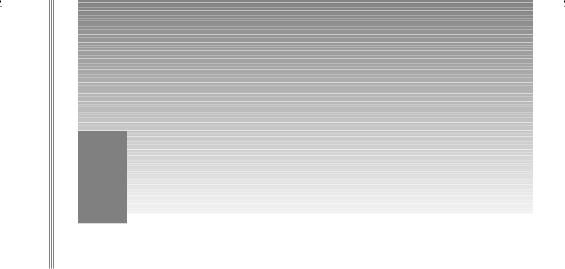
Cagle R.B. - Blueprint for Project Recovery[c] A Project Management Guide (2003)(en)
.pdf
Blueprint for Project Recovery— A Project
Management Guide |
||
|
|
Y |
|
L |
|
|
F |
|
|
M |
|
A |
|
|
Ronald B. Cagle |
||
E |
|
|
T |
|
|
AMACOM

Blueprint for
PROJECT
RECOVERY—
A Project
Management Guide

This Page Intentionally Left Blank

Blueprint for
PROJECT
RECOVERY—
A Project
Management Guide
The Complete Process for Getting Derailed Projects Back on Track
Ronald B. Cagle
American Management Association
New York • Atlanta • Brussels • Buenos Aires • Chicago • London • Mexico City San Francisco • Shanghai • Tokyo • Toronto • Washington, D.C.

Special discounts on bulk quantities of AMACOM books are available to corporations, professional associations, and other organizations. For details, contact Special Sales Department, AMACOM, a division of American Management Association, 1601 Broadway, New York, NY 10019.
Tel.: 212-903-8316. Fax: 212-903-8083. Web site: www.amacombooks.org
This publication is designed to provide accurate and authoritative information in regard to the subject matter covered. It is sold with the understanding that the publisher is not engaged in rendering legal, accounting, or other professional service. If legal advice or other expert assistance is required, the services of a competent professional person should be sought.
Various names used by companies to distinguish their software and other products can be claimed as trademarks. AMACOM uses such names throughout this book for editorial purposes only, with no intention of trademark violation. All such software or product names are in initial capital letters or ALL CAPITAL letters. Individual companies should be contacted for complete information regarding trademarks and registration. A list of these trademarks can be found on page 273 following the bibliography.
Library of Congress Cataloging-in-Publication Data
Cagle, Ronald B.
Blueprint for project recovery : a project management guide : the complete process for getting derailed projects back on track / Ronald B. Cagle.
p. cm.
Includes bibliographical references and index. ISBN 0-8144-0766-8 (hardcover)
1. Project management. I. Title.
HD69.P75 C345 2003 |
|
658.4 04—dc21 |
2002011733 |
2003 Ronald B. Cagle All rights reserved.
Printed in the United States of America.
Although this publication is subject to copyright, permission is granted free of charge to reproduce the forms that are required by each user and to print and use pages from the enclosed CD-ROM. Only the original purchaser may make copies. Under no circumstances is permission granted to sell or distribute on a commercial basis material reproduced from this publication.
Except as provided above, this publication may not be reproduced, stored in a retrieval system, or transmitted in whole or in part, in any form or by any means, electronic, mechanical, photocopying, recording, or otherwise, without the prior written permission of AMACOM, a division of American Management Association, 1601 Broadway, New York, NY 10019.
Printing number
10 |
9 |
8 |
7 |
6 |
5 |
4 |
3 |
2 |
1 |

TABLE OF CONTENTS
PREFACE |
|
xiii |
ACKNOWLEDGMENTS |
xvii |
|
CHAPTER 1 |
|
|
GETTING STARTED |
1 |
|
1.1 |
General |
3 |
1.2 |
Requirements |
7 |
1.3 |
The Search Methodology |
7 |
CHAPTER 2 |
|
|
CHECKING PROGRAMMATIC PERFORMANCE |
9 |
|
2.1 |
General |
9 |
2.2 |
Programmatic Performance Checklist |
9 |
2.3 |
Programmatic Explanations |
10 |
CHAPTER 3 |
|
|
CHECKING TECHNICAL PERFORMANCE |
38 |
|
3.1 |
General |
38 |
3.2 |
Technical Performance Checklist |
38 |
3.3 |
Technical Explanations |
41 |
v

vi |
T A B L E O F C O N T E N T S |
|
CHAPTER 4 |
|
|
RECOVERING FROM PROGRAMMATIC PROBLEMS |
56 |
|
4.1 |
General |
56 |
4.2 |
Programmatic Recovery Checklist |
56 |
4.3 |
Programmatic Recovery Cause Descriptions |
58 |
CHAPTER 5 |
|
|
RECOVERING FROM TECHNICAL PROBLEMS |
109 |
|
5.1 |
General |
109 |
5.2 |
Technical Search Tables |
109 |
5.3 |
Technical Recovery Cause Descriptions |
112 |
CHAPTER 6 |
|
|
EXPANDING THE CAUSE BASE FOR YOUR PROJECT |
156 |
|
6.1 |
General |
157 |
6.2 |
Brainstorming |
158 |
6.3 |
Researching Appropriate Benchmarks |
160 |
6.4 |
Researching the Processes |
161 |
6.4.1 |
Standard Processes |
161 |
6.4.2 |
Customer Processes |
162 |
6.4.3 |
Enterprise Processes |
162 |
6.4.4 |
Project/Program Processes |
162 |
CHAPTER 7 |
|
|
GROUPING THE CAUSES FOR ACTION |
165 |
|
7.1 |
General |
165 |
7.2 |
Ordering Techniques |
165 |
7.2.1 |
85:15 Rule |
166 |
7.2.2 |
Cause and Effect Diagram |
167 |
7.2.3 |
Affinity Diagrams |
171 |
7.2.4 |
Relationship Diagrams |
173 |
7.3 |
Interrelationships of Causes |
176 |

T A B L E |
O F C O N T E N T S |
vii |
CHAPTER 8 |
|
|
SELECTING THE BEST OF THE BEST |
177 |
|
8.1 |
General |
177 |
8.2 |
Evaluation Techniques |
178 |
8.2.1 |
Pareto Analysis |
178 |
8.2.2 |
Force Field Analysis |
180 |
8.2.3 |
Failure Mode Effect Analysis (FMEA) |
182 |
8.2.4 |
Monte Carlo Simulation |
184 |
8.3 |
Eliminating Holes and Overlaps |
186 |
8.4 |
Choosing the Causes |
187 |
CHAPTER 9 |
|
|
IMPLEMENTING THE TAILORED CHANGES |
188 |
|
9.1 |
General |
188 |
9.2 |
Implementation Techniques |
188 |
9.2.1 |
Slipping in the Fix |
189 |
9.2.2 |
Creating ‘‘On-Ramps’’ |
189 |
9.2.3 |
‘‘Dumping’’ the Fix |
190 |
9.3 |
Selecting Your Technique |
190 |
CHAPTER 10 |
|
|
CONCLUDING |
191 |
|
10.1 |
General |
191 |
10.2 |
The Concluding Process |
192 |
10.2.1 |
Quantum Improvement |
192 |
10.2.2 |
Documentation |
193 |
10.3 |
Data Trail |
195 |
10.4 |
Modifying Methods |
196 |
CHAPTER 11 |
|
|
USING THE COMPACT DISK (CD) |
197 |
|
11.1 |
General |
197 |
11.2 |
Loading |
198 |
11.3 |
Using the Tables |
198 |
11.4 |
Using the Attachments |
198 |

viii |
T A B L E |
O F C O N T E N T S |
SUMMARY |
|
199 |
GLOSSARY |
|
203 |
ATTACHMENTS |
217 |
|
1 |
Standard Program Plan Outline |
219 |
2 |
Standard Technical Plan Outline |
223 |
3 |
Risk Mitigation Plan |
227 |
4 |
Contract/Subcontract Outline |
231 |
5 |
Configuration Management Plan Outline |
234 |
6 |
Quality Assurance Plan Outline |
237 |
7 |
Requirements Traceability Matrix |
241 |
8 |
Requirements Flow-Down Matrix |
245 |
9 |
Data Delivery Matrix |
247 |
10 |
Capability Matrix |
249 |
11 |
Policy-to-Plan Trail |
251 |
12 |
Experience Window |
253 |
13 |
Standards Traceability Matrix |
255 |
14 |
Vendor Evaluation Process |
258 |
15 |
Design Review Approval Form |
263 |
16 |
In-Process Review Approval Form |
265 |
17 |
Negotiation Checklist |
267 |
18 |
Critical Success Factor (CSF) Matrix |
269 |
BIBLIOGRAPHY |
271 |
|

FIGURES
Figure 1-1 |
Project/Program Environment |
2 |
Figure 1-2 |
Project/Program Requirements Control |
|
|
Relationships |
4 |
Figure 1-3 |
Documentation Interrelationships |
5 |
Figure 2-1 |
Vendor Evaluation Sheet |
32 |
Figure 4-1 |
Vendor Evaluation Sheet |
93 |
Figure 5-1 |
Requirements Allocation |
123 |
Figure 5-2 |
Design Review Approval Form |
128 |
Figure 5-3 |
In-Process Review Approval Form |
130 |
Figure 7-1 |
Fishbone Diagram |
168 |
Figure 7-2 |
Tree Diagram |
169 |
Figure 7-3 |
Affinity Diagram |
172 |
Figure 7-4 |
Relationship Diagram |
174 |
Figure 8-1 |
Pareto Analysis: Raw Data |
179 |
Figure 8-2 |
Pareto Analysis: Ordered Data |
179 |
Figure 8-3 |
Force Field Schematic |
181 |
Figure 10-1 |
A Typical Traditional Library |
194 |
Figure 10-2 |
Schematic of an Electronic Library |
195 |
Figure A3-1 |
Risk Mitigation Form |
228 |
Figure A13-1 Policy-to-Program Plan to Support Document Flow |
257 |
|
Figure A14-1 Vendor Evaluation Sheet |
260 |
|
Figure A14-2 Vendor Evaluation Summary |
261 |
|
Figure A14-3 Vendor Selection Summary Score Sheet |
262 |
|
Figure A15-1 Design Review Approval Form |
264 |
|
Figure A16-1 In-Process Review Approval Form |
266 |
|
ix
